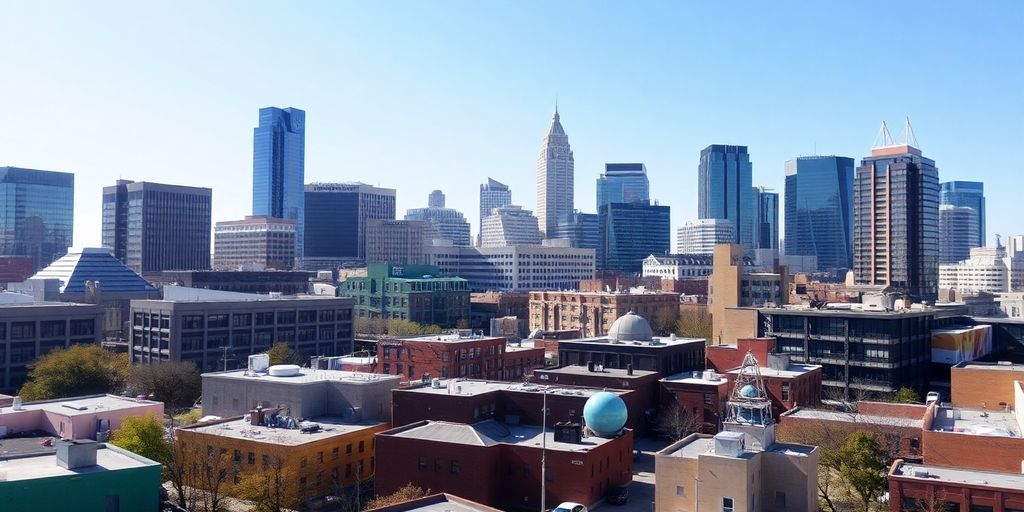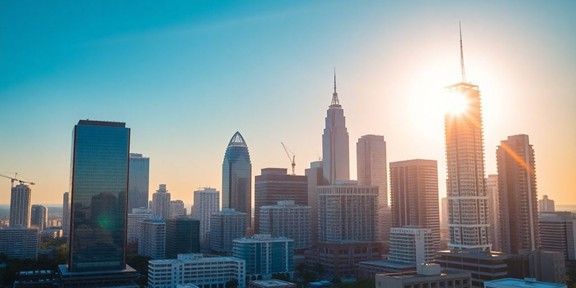Remote Work and Real Estate in 2025: The Big Shifts You Need to Know
Blog Author - Published Date
The way we work has really changed, hasn't it? Since 2020, working from home has gone from a rare thing to something super common. This big shift means people are thinking differently about where they live and what they need in a home. It's not just about our houses, either. The places we used to go to work every day are changing too. We're looking at 2025, and remote work is still shaking things up in the real estate world, affecting everything from city apartments to suburban houses. Let's break down some of the main remote work and real estate trends we're seeing.
Key Takeaways
- Remote work has pushed people out of big cities and into suburbs and rural areas, looking for more space and lower costs.
- A dedicated home office is now a must-have feature for many homebuyers, influencing how houses are designed and priced.
- Traditional city office buildings are seeing less demand, leading to new ideas for what to do with that space.
- Technology, especially fast internet, is a major factor in what people want in their homes now.
- There's a growing interest in homes that are good for our health and the environment, with energy efficiency becoming more important.
The Shifting Residential Landscape Driven by Remote Work
The way we think about where we live has really changed, hasn't it? With so many jobs now allowing people to work from anywhere, the old rules about needing to be close to a city office just don't apply anymore. This has caused some pretty big market shifts, especially in housing. We're seeing a clear trend of people moving out of dense urban areas.
Migration to Suburban and Rural Havens
Lots of folks are packing up and heading for the suburbs and even further out into rural areas. The appeal of more space, a lower cost of living, and often a more relaxed pace of life is a huge draw. People are looking for bigger homes, yards for the kids or pets, and generally just more breathing room. This has definitely boosted suburban growth and changed the dynamics of these previously quieter markets. It’s interesting to see how these relocation patterns are reshaping communities across the country. You can find more on this trend at [8cff].
The Essential Home Office: A New Must-Have
Forget just needing a spare bedroom; a dedicated home office is now a major selling point. Buyers are actively looking for properties that already have a functional workspace or at least the potential to create one easily. This means more natural light, good ventilation, and importantly, reliable internet. The demand for a proper home office setup is a direct result of remote work becoming the norm for many.
Hybrid Models and Their Residential Implications
Even for those not fully remote, hybrid work schedules are common. This means people still value being somewhat connected to urban centers for occasional office visits or social activities. So, we're seeing a rise in demand for homes that offer a good balance – perhaps in well-connected suburbs or smaller cities that still provide access to amenities and job opportunities without the full urban grind. It’s all about finding that sweet spot between work flexibility and lifestyle convenience.
Commercial Real Estate's Evolving Identity
The way we work has changed, and commercial real estate is definitely feeling the ripple effects. With so many companies embracing remote or hybrid setups, the need for massive, centralized office buildings just isn't what it used to be. This has led to a noticeable dip in demand for traditional urban office spaces. Many businesses are downsizing, rethinking their footprint, or even ditching physical offices altogether. It's a big shift, and it means landlords and developers are having to get creative.
Declining Demand for Traditional Urban Office Space
Vacancy rates are up in many city centers. Companies that once leased huge floors are now looking at smaller, more flexible arrangements. This isn't to say offices are dead, but the old model of everyone commuting to a big downtown building every day is definitely fading. It’s a tough market for older office buildings that aren't adaptable.
Repurposing Office Buildings for New Uses
So, what happens to all those empty offices? Well, the smart money is on repurposing. We're seeing more conversions into residential units, hotels, or even mixed-use developments that combine living, working, and leisure. This trend helps revitalize urban areas and meets new demands, turning a potential problem into an opportunity. It’s a big change for city planning and commercial property.
The Rise of Flexible and Shared Work Environments
Instead of long-term leases on massive spaces, companies are increasingly looking for flexibility. This means more demand for co-working spaces, serviced offices, and shorter lease terms. These environments cater to hybrid teams, offering meeting rooms and collaborative areas when needed, without the overhead of a full-time office. It’s all about adaptability and providing spaces that fit the modern workforce's needs.
Technological Integration and Connectivity in 2025 Homes
So, with everyone working from home these days, our houses are basically our offices, right? This means the tech inside our homes has to keep up. By 2025, we're seeing a big push for homes that are not just comfortable, but also super connected and smart. It’s not just about having Wi-Fi anymore; it’s about how that Wi-Fi works and what else it can do.
Smart Home Features for the Remote Worker
Think about it: your home is now your command center. Smart thermostats that learn your schedule, lights you can control from your phone, and even smart locks for when you need to let a delivery person in – these are becoming standard. These gadgets aren't just fancy extras; they're tools that help manage your day and make working from home smoother. For instance, voice-activated assistants are expected to be in about 70% of homes, making it easy to set reminders or play background music without lifting a finger. It’s all about making your living space work for you.
Prioritizing High-Speed Internet and Robust Connectivity
This is probably the most important part. If your internet is spotty, your workday is toast. We're talking about homes needing serious bandwidth. It’s not just about streaming movies; it’s about video calls that don’t freeze, large file transfers that happen quickly, and cloud-based work tools that run without a hitch. Builders are really starting to focus on making sure new homes have top-notch internet infrastructure built right in. You can find more on how new construction is integrating these systems at new smart home technology.
Cybersecurity Measures in Connected Homes
With all these smart devices talking to each other and the internet, security is a big deal. Nobody wants their personal information or their home network compromised. So, expect to see more homes coming with built-in security features that protect against online threats. This could mean more secure routers, automatic software updates for devices, and even dedicated networks for your smart gadgets. It’s like putting a good lock on your digital front door.
Sustainability and Wellness in the New Real Estate Era
It's not just about having a place to crash anymore, right? Especially with so many of us working from home, our living spaces have to do more. We're talking about places that feel good to be in, day in and day out. This means builders and buyers alike are really starting to care about how homes impact our health and the planet. Think less about just square footage and more about how the place makes you feel and its footprint.
Features Promoting Health and Well-being
People are looking for homes that actively support a healthy lifestyle. This includes things like better air quality, access to natural light, and spaces that encourage movement. We're seeing a rise in demand for homes with features like:
- Improved ventilation systems
- Large windows and skylights
- Dedicated spaces for exercise or yoga
- Proximity to parks and green spaces
The focus is shifting from purely functional living to spaces that nurture mental and physical health, a direct response to spending more time indoors.
The Growing Importance of Green Building Practices
Going green isn't just a trend; it's becoming a standard expectation. Buyers are increasingly aware of the environmental impact of their homes. This translates to a higher demand for properties that utilize sustainable materials, incorporate energy-efficient designs, and minimize waste during construction. Expect to see more homes built with recycled materials, low-VOC paints, and water-saving fixtures.
Energy Efficiency as a Key Differentiator
Saving money on utility bills is always a plus, but energy efficiency is now a major selling point. Homes equipped with features like solar panels, high-performance insulation, and smart thermostats are becoming more attractive. These aren't just nice-to-haves; they're becoming key factors in property value and desirability, especially as energy costs continue to fluctuate. The table below shows some expected increases in popularity for these features:
| Sustainable Feature | Expected Popularity Increase (%) |
|---|---|
| Energy-efficient appliances | 40% |
| Green roofs | 30% |
| Solar panels | 50% |
Impact on Rental Markets and Future Predictions

The rental market is definitely feeling the ripple effects of widespread remote work adoption. We're seeing a noticeable shift in where people want to live, and that's changing demand patterns for rental properties. Cities that were once the go-to for renters are now experiencing a bit of a slowdown, while smaller towns and suburban areas are seeing more interest. This isn't just a temporary blip; it looks like a more lasting change in how people approach their living situations.
Rental Demand Shifts in Urban vs. Suburban Areas
Downtown cores, which used to be packed with young professionals and students, are now seeing less demand for rentals. Companies are downsizing their office spaces, meaning fewer people are commuting daily. This has led to a stabilization, and in some cases, a slight drop in rental prices in these urban centers. On the flip side, suburban and even rural areas are becoming more popular. People are looking for more space, and the ability to work from anywhere means they don't have to be tied to a city center. This increased demand in these areas is naturally pushing up property values and rents.
Mid-Sized Cities as Emerging Rental Hubs
It's not just the suburbs; many mid-sized cities are also becoming attractive rental markets. These places often offer a better balance of affordability, amenities, and a good quality of life, especially for those who can now work remotely. They're becoming hubs for people looking to escape the higher costs of major metropolitan areas but still want access to jobs and a vibrant community. We're seeing new rental supply coming online in these areas, which is good for keeping rents somewhat in check, though demand is still strong.
Long-Term Outlook for Remote Work and Real Estate
Looking ahead, the trend of remote work seems set to continue shaping the real estate landscape. The flexibility it offers is a big draw for many workers. This means that the demand for housing with dedicated home office space will likely stay high. We can also expect to see more investment in areas that benefit from this distributed workforce. The overall rental market will likely see increased vacancy rates in traditional urban centers as new supply comes online and demand softens. This could lead to more competitive rents in those areas, while suburban and mid-sized city markets continue to grow. It's a dynamic situation, and understanding these shifts is key for anyone involved in real estate investment.
Here's a quick look at what we might expect:
- Urban Rental Markets: Expect slower rent growth and potentially higher vacancies as people move out.
- Suburban and Rural Markets: Continued strong demand, leading to rising rents and property values.
- Mid-Sized Cities: Growing popularity as attractive alternatives to major urban centers.
The influx of new rental units, combined with a potential slowdown in population growth from certain demographics, is expected to ease pressure on rents in some markets. However, the desirability of certain locations for remote workers will keep demand robust in others.
Regional Market Dynamics and Investment Opportunities
When we look at how real estate is shaking out across the country in 2025, it's clear that remote work has really mixed things up. It's not just about where people work anymore; it's about where they want to live, and that's changing the game for different areas. The Southern and Northeastern cities are definitely gaining some serious traction.
Southern and Northeastern Cities Gain Prominence
The South, in particular, is seeing a big surge. About 80% of the top zip codes expected to see significant price jumps are located down there. Why the South? Well, affordability is a huge draw. Homes are generally less expensive than in other parts of the country, which appeals to a lot of people looking for more space and value. Plus, many Southern suburbs are really stepping up their game with amenities that families appreciate. It's not just about the price, though; population growth and job opportunities are also pulling people in. Meanwhile, states like Rhode Island, Connecticut, and New Jersey in the Northeast are also quietly experiencing double-digit growth in home values. This shift means that places that might not have been top-tier investment spots before are now really worth a second look. For anyone thinking about where to put their money, keeping an eye on these growing regions is smart. You can find more insights on how technology is changing the property game at property tech trends.
Affordable Housing Demand Across Markets
Across the board, the demand for affordable housing is still super strong. With economic uncertainties and rising living costs, people are really focused on finding places that fit their budget. This trend is pushing up prices in more affordable areas, even as some other markets might cool down a bit. It’s a bit of a balancing act, with some experts predicting price dips in certain spots while others see continued climbs due to high buyer interest. It really depends on the local economic picture and how many homes are actually available.
Opportunities in Retail and Industrial Properties
Beyond just homes, the ripple effects of remote work are also creating opportunities in other property types. While traditional urban office spaces might be seeing less demand, there's a growing interest in repurposing those buildings for new uses. Think residential conversions or mixed-use developments. The retail sector is also adapting, with a focus on experiential shopping and local convenience. Industrial properties, especially those supporting e-commerce and logistics, continue to be strong performers. The way people shop and work is changing, and that means the types of buildings we need are changing too. It's all about adapting to new buyer preferences and economic shifts.
Wrapping It Up: What's Next for Real Estate?
So, looking at everything, it's pretty clear that working from home has really shaken up the real estate world. People are moving to different places, needing different kinds of homes, and even how we use office buildings is changing. For anyone buying, selling, or investing in property in 2025, keeping these shifts in mind is super important. The market is definitely different now, and it's going to keep changing as more people work remotely. Contact Us
Frequently Asked Questions
Why are people moving out of cities because of remote work?
Because many people can now work from home, they are moving out of big cities. They want more space, like bigger yards, and often find that homes are cheaper in the suburbs or the countryside. This means more people are buying houses in these areas, making prices go up.
Is a home office a big deal for houses now?
Having a place at home to work, like a separate room or a quiet corner, is super important now. Many new homes are being built with these special work areas. If a home has a good spot for an office, it can be worth more money.
How do hybrid work schedules (part home, part office) change where people want to live?
Yes, some companies are letting employees work from home part of the week and come to the office the other part. This affects where people want to live. They might want a home that's not too far from the city but still offers the nice things about living in the suburbs.
Are office buildings in cities still as popular for businesses?
Not as many companies need big office buildings in cities anymore because many workers are remote. This means fewer people are renting office spaces, and some buildings might be changed into apartments or other things.
What kind of technology is important in homes for remote workers?
People want homes with fast internet and smart gadgets that make working from home easier. Also, having good internet and security for your computer is very important for people working remotely.
Are things like health, wellness, and being eco-friendly important in real estate now?
Yes, homes with things that help people feel good, like clean air, lots of sunlight, and green spaces, are becoming more popular. Using eco-friendly building methods and saving energy are also becoming standard for new homes and buildings.














